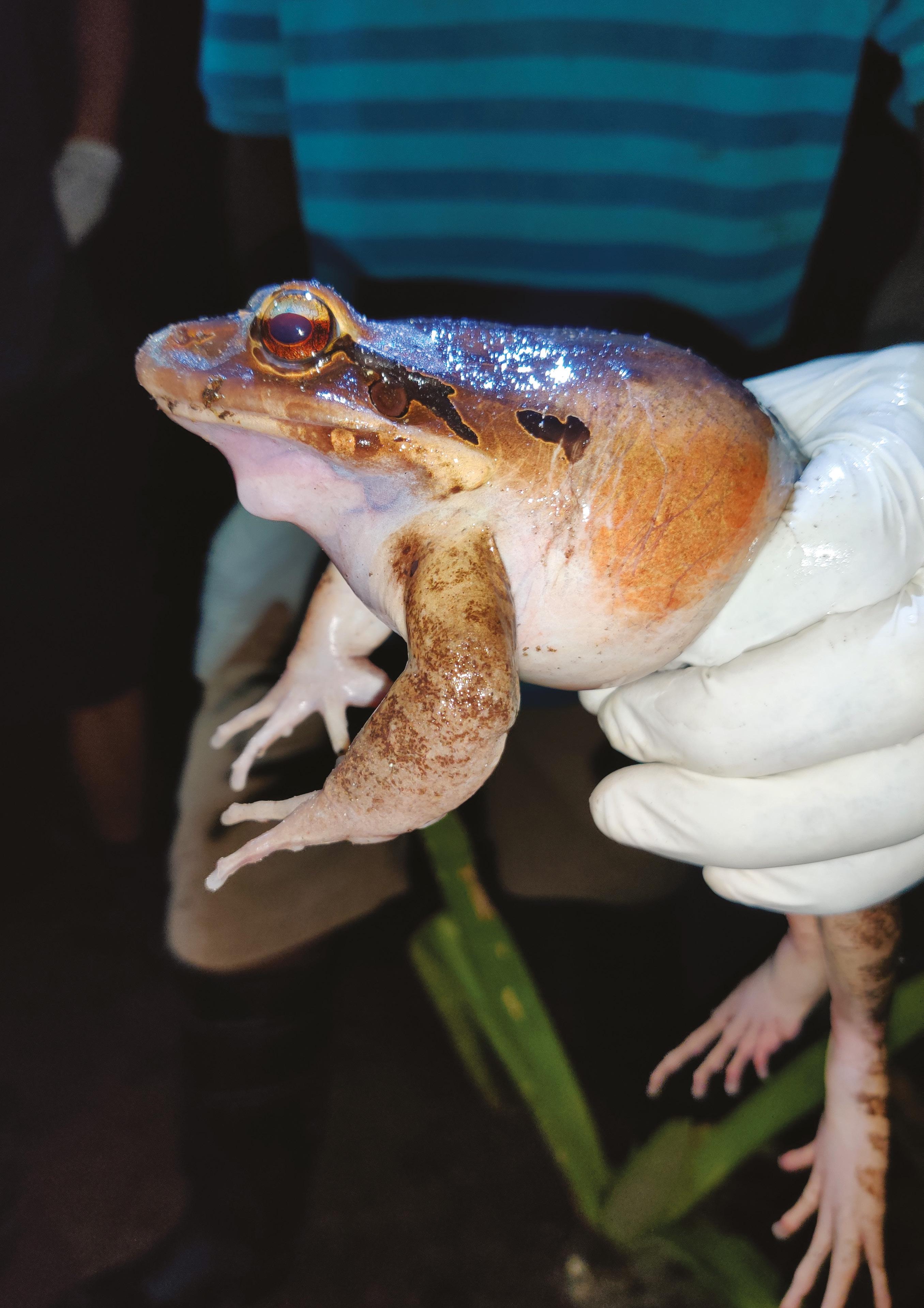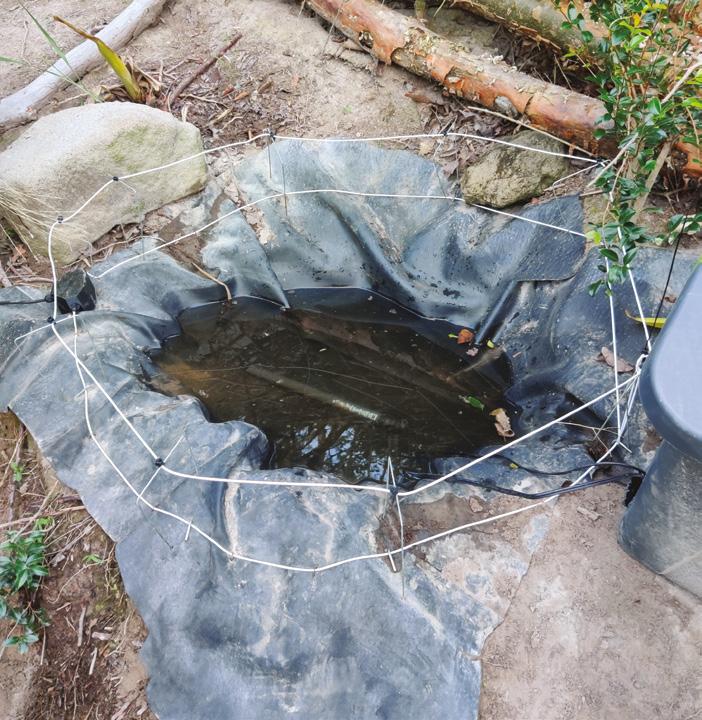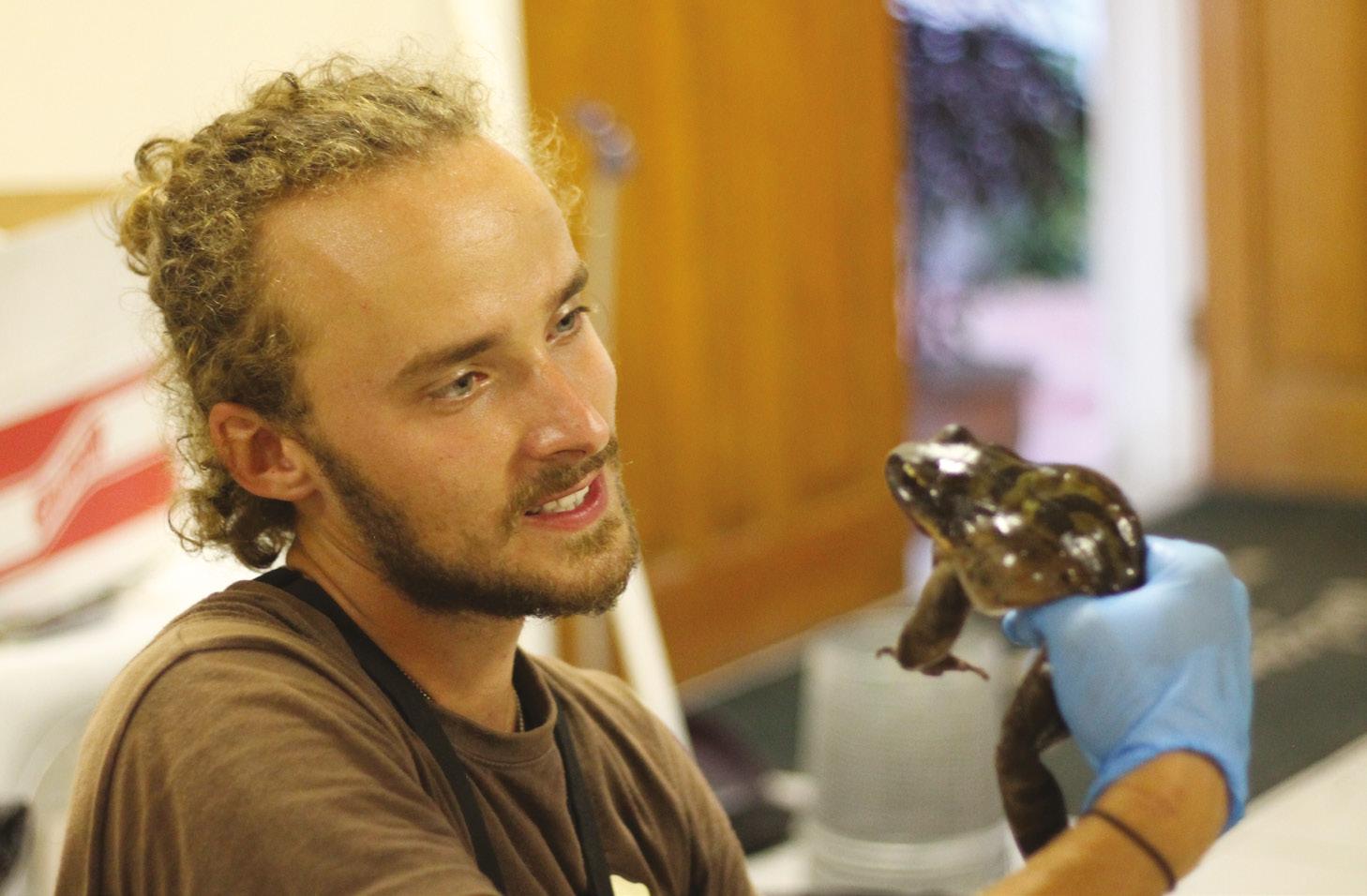
5 minute read
Hot tubs for sick frogs
Hot tubs for sick frogs
PROJECT COORDINATOR FOR THE MOUNTAIN CHICKEN RECOVERY PROGRAMME LUKE JONES TELLS US ABOUT HIS WORK RETURNING THESE CRITICALLY ENDANGERED FROGS TO MONTSERRAT.
Advertisement

A mountain chicken being checked for signs of disease
The mountain chicken frog is native only to the Caribbean islands of Dominica and Montserrat. The species was driven to the brink of extinction by a deadly microscopic fungus called chytrid, which is believed to be the cause of over 500 documented extinctions and declines of amphibians worldwide. Luke is part of a team looking to re-establish the frogs on Montserrat and protect them from the fungus by manipulating the environment in semi-wild enclosures. Earlier this year, 27 captive-bred mountain chickens arrived in Montserrat from Jersey Zoo and ZSL London Zoo and were released into the enclosures. The success of this project will see the establishment of the first breeding population of mountain chickens on Montserrat in 10 years.
WHAT STAGE WAS THE PROJECT AT WHEN YOU JOINED?
The team had already attempted four releases of mountain chickens into the wild on Monserrat, but they had been unsuccessful. So we were back to the drawing board trying to come up with a new plan. One thing we learned from previous releases was that chytrid cannot survive in temperatures above 30°C. We tried releasing frogs during the hot season and using anti-fungal treatments to guide them through the cold season. However, we still lost individuals as we were just treating them, not curing them. Eventually, we came up with the idea of releasing the frogs into temperature-controlled seminatural enclosures.

A heated pool in the semi-wild enclosure

Luke Jones with one of the mountain chickens to arrive in Montserrat
HOW DO THE ENCLOSURES WORK?
The hope is they will act in a similar way to a vaccine. Where a vaccine is a weakened state of a virus or disease that your body is better able to counter and then develop a resistance; the enclosures are designed to weaken the prevalence of the chytrid fungus within the environment. Mountain chickens suffering from it, or with little resistance to it, can survive in areas of the enclosure where the fungus is weakest. The enclosures are split into a warm side and a cool side. The “cool side” is just the natural environmentwith the natural background level of chytrid. The warm side is where we have implemented environmental manipulation by installing heated ponds and removing the canopy cover to increase solar radiation to the ground level. This will make the temperature too high for chytrid to survive, so frogs suffering from chytrid will use the warmer side. Those that do not need it will take advantage of less competition for food and space in the cool side. Individuals in this cooler side will come into contact and breed together and, over time, we should hopefully see the population develop an increased resistance to the fungus.
HOW LONG WILL IT LIKELY TAKE FOR THE FROGS TO GAIN RESISTANCE TO CHYTRID?
We are expecting it to take 3-5 years minimum, but it could be longer. We know that it can happen as we saw it happen naturally in Dominica. The population over there crashed to the point that the frogs were believed to be extinct for 10 years. A few individuals must have had enough resistance to survive in that time. We are also not sure exactly how they will develop this resistance, whether it’s changes to the microbiome on their skin, their immune system or it could even be behavioural. It might be a case that they learn to utilise hot spaces in their environment. Either way, we are trying to find that out.
WHAT HAVE BEEN THE BIGGEST CHALLENGES IN SETTING UP THE PROJECT?
A lot of things had to be started from scratch. We had to survey the island for new habitats, form new relationships with landowners and find a suitable place for our insect breeding centre, to breed extra food for the frogs. A major challenge was to catch wild insects by hand and then breed enough to feed our 27 frogs, each of which eat around 700 crickets weekly. One of the hardest things was finding the materials for all of this, which can be
WHEN COULD THEY BE INTRODUCED TO THE WILD?
If we see resistance to the fungus, we will probably look at expanding the facility to increase the range over which the frogs are spread. If by the end of next year they have bred, and we had no instance of disease, we could look at releasing the offspring into the wild as they may have already developed resistance. But that is just one of many different options, we are very much learning as we go along.
HOW IS THE LOCAL COMMUNITY RESPONDING TO THIS PROJECT?
It is very mixed. Older generations knew a time when mountain chickens were on the island, and they miss them. They grew up with the sound of them calling at night. It was an identity of their island, and I don’t think they really noticed it until they lost it. It was also a valuable resource and contributed to the island’s economy through tourism, which particularly benefitted the more impoverished people. The problem we have is that younger generations don’t remember it, they don’t have that deep emotional connection. We need to re-establish that connection for them to support the project. Montserrat lost a part of its identity when the frogs went extinct, and we now have the opportunity to give back a little bit of what makes it unique.
WHAT WAS IT LIKE TO HEAR THEM CALLING ON MONTSERRAT FOR THE FIRST TIME IN YEARS?
It’s hard to put into words, but it was just complete euphoria! I had never actually heard a mountain chicken calling until then. It was like a myth had been made real. You hear all of these “legends” of what the call is like, which everyone describes differently. To listen to it for yourself is just, wow! We also felt proud that this is something we had achieved. We have been able to put a species back where it belongs. After all of the stress and pressure, hearing that call relieved everything. All of the hard work was worth it just for that.










